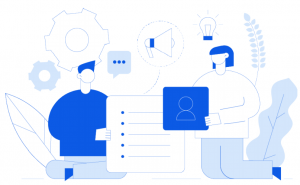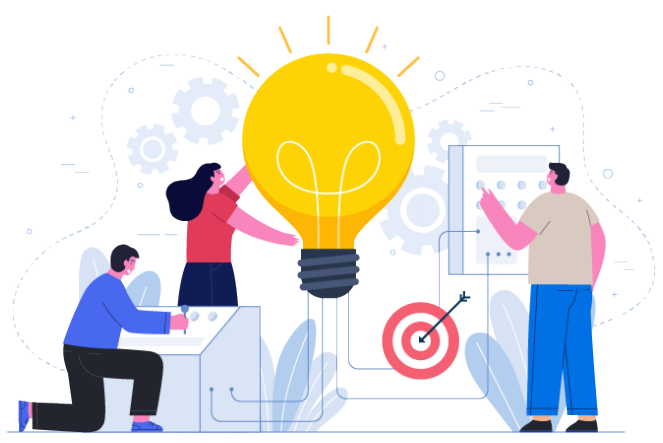
As times take a turn, we turn to an industry veteran to take her opinion on the changing role of HR. In this special conversation with Ms Madhavi Lall, we asked her about her glorious three decades in the industry, and her insights on recruitment planning in a Post-Covid World. We also talked to her about Deutsche Bank’s close monitoring of COVID-19, from both a holistic employee and a business perspective, and the initiatives and programs in place to support the health and well-being of their employees.
JOURNEY
Q - With your versatile and rich experience of almost 3 decades across different industries in Human Resource, how would you describe your journey so far? What were some of the challenges and important decisions that helped you evolve into a leader and get where you are today? What is your secret sauce?
A - Three decades make me sound really old. Time has flown by probably because I have had a very exciting and somewhat of a roller coaster ride.
In my opinion, there is no single path or formula to success. In fact, the definition of success can vary from person to person and can also vary at different points in life. It is important that we accept our choices and make the best out of these.
If I were to bucket the challenges and many important decisions, they would be:
- Take a career break because of family reasons or not
- Move internationally or not
- Pitch for a role I really want and try and make a huge difference when I do get that role.
It is challenging for women and continues to be- because of gender roles and entrenched social conditioning. At many points in my career, I did contemplate whether my son needed me at home and it was not an easy decision to make – I had to build a strong support system at home to be comfortable with continuing to work.
To be together as a family, I did not consider international moves either. The flipside was that when I was ready for international moves, the opportunities did not really come through. In my opinion, there is no single path or formula for success. In fact, the definition of success can vary from person to person and can also vary at different points in life. It is important that we accept our choices and make the best out of these.
 I was not geographically mobile so I did the next best thing – opted for projects which gave me huge learning and exposure. My focus has been on doing more and more and like my generation, I believe in hard work, a cue I learnt from my father. And this is not necessarily only about long hours, but also impactful outcome-driven work. I do believe hard work and dedication pays off – nothing can really replace that in the long run. It builds professional capability and reputation.
I was not geographically mobile so I did the next best thing – opted for projects which gave me huge learning and exposure. My focus has been on doing more and more and like my generation, I believe in hard work, a cue I learnt from my father. And this is not necessarily only about long hours, but also impactful outcome-driven work. I do believe hard work and dedication pays off – nothing can really replace that in the long run. It builds professional capability and reputation.
I got my first big leadership role by preparing a plan in advance as to what I would achieve if I got the role. I probably got the job through onboarding people to my vision and plan. As soon as I got the job, my objective was to set an ambitious agenda based on business needs and truly make a difference.
I would talk about a few “not so secret” sauces.
The first one is what I learned from my mother – always have a “can-do attitude.” She was someone who came from a well to do family and had never worked for a living until she turned forty and then had to figure out a way to manage the dire financial crises we were suddenly faced with. Her grit, determination and hard work in bringing up three children is something that continues to inspire all of us. The other sauces that helped me – a fair amount of optimism, hard work, networking (for me that means creating a community of ideas and mutual upliftment), a high level of curiosity to learn new things and great joy in working with people.
HR STRATEGY
Q - There has been an increasing need to align talent strategies with business strategies. What are some of the factors fueling the importance of this alignment and how can it help companies plan for long-term growth as well as uncertainty?
A - Talent strategy will be effective only if it is aligned with the business strategy. The goal of talent management is to create a high-performance culture to meet the organisation’s strategic, business and operational goals.
With business scenarios changing constantly, jobs are being redesigned and the talent needs are also changing and evolving rapidly.
A good talent plan and strategy can truly help in making an organisation future-ready by enabling its employees to upskill, reskill and successfully adapt to the ever-changing business and job dynamics.

A few areas of impact would be:
- Leadership building and succession planning
- Fostering a multigenerational workforce
- Upskilling for career development and preparing people for the future and in a way reducing mental stress: This is a big area of focus especially in the current times where people are living in the fear of becoming redundant, losing their jobs to new technologies.
A good talent plan and strategy can truly help in making an organisation future-ready by enabling its employees to upskill, reskill & successfully adapt to ever-changing business & job dynamics. Click To Tweet
Recruiters and hiring managers are already embracing the change – they need to just be aware of and plan for some of the risks associated with remote hirings like the consistency of hiring, potential frauds and cultural assimilation. What we will need to build is a further standard interview process and identify the most critical skills for the job.
RECRUITMENT
Q - Experts believe that the Covid-19 pandemic will have long-lasting effects on the recruitment industry. In your opinion, how will recruitment planning look after COVID-19? How can recruiters and hiring managers prepare themselves to brace the changes and manage the talent challenges of COVID-19?
A - Even before the current situation emerged, the way we work and the advancement in technology was disrupting jobs and the skills needed to do them. The pandemic has made the action more urgent and shown us ways we can work remotely and in some cases, better and faster. We need to capitalize on these learnings.
The remote hiring process for us has evolved in the past couple of months. A shift has been noticed even in the mindset of hiring managers - while initially there was some amount of hesitation towards virtual interviews, given the preference for ‘in-person’ interactions, we have started getting comfortable with virtual interviews.
Recruiters and hiring managers are already embracing the change – they need to just be aware of and plan for some of the risks associated with remote hirings like the consistency of hiring, potential frauds and cultural assimilation. What we will need to build is a further standard interview process and identify the most critical skills for the job.
I think one of the areas worth exploring is the availability of new talent pools with remote working - people who are not able to work from office because of personal reasons or persons with certain disabilities, etc. We need to ensure that we tap this huge talent base which is location agnostic.
HR needs to champion the employee experience during these times. We need to realize that some of the talent who are being laid off now can come back to the organisation in the future. At Deutsche Bank, we have a robust internal mobility process which helps us retain and grow our talent.
TALENT MANAGEMENT
Q - Outplacement services have become an established mature product in the talent management space. Why is outplacement so crucial and how is it linked to the overall employee experience? What role should HR play in outplacement?
A - With the current evolving scenario, businesses will re-evaluate their cost of operations. This might, in some cases result in either redundancy or reskilling/upskilling of employees. The former necessitates outplacement services to support employees’ transition to new jobs.
No company prefers laying off people but with the tough economic environment that the world is facing currently, this is a reality. Outplacement services offer practical and emotional specialist career coaching support and enable an individual to circumnavigate the competitive job market and move into suitable new jobs as soon as possible. These services can also balance the demand-supply gap as there could be a downside in some sectors and upswings in certain others.
HR needs to champion the employee experience during these times. We need to realize that some of the talent who are being laid off now can come back to the organisation in the future.
At Deutsche Bank, we have a robust internal mobility process which helps us retain and grow our talent.

LEARNING AND DEVELOPMENT
Q - As businesses cancel in-person training due to the pandemic, they are widely turning to virtual learning programs. How is Deutsche Bank approaching the upskilling challenge and reimagining virtual learning and offering online coaching to make employees future-ready?
A - Deutsche Bank always had a focus on virtual learning to give staff the flexibility to learn what they like and are passionate about and in their own time. Post pandemic, we further adapted to the changing needs with agility. The digital learning curriculum has been revisited and reprioritized to enable employees to leverage resources creatively through blended learning methodologies.
We are also leveraging skills of our leaders as trainers and reaching out to a larger audience with short, modular learning sessions.
The pre-pandemic silos are giving way to seamless learning and exchange, no longer bound by constraints of geographies. This is giving people a larger canvas to explore and learn from each other and experience Deutsche Bank in a more comprehensive manner.
We are also evaluating some of the new skills that need focus and working on learning solutions to build these across the organisation.
The pre-pandemic silos are giving way to seamless learning and exchange, no longer bound by constraints of geographies. This is giving people a larger canvas to explore and learn from each other and experience Deutsche Bank in a more comprehensive manner.
ORGANISATIONAL CULTURE
Q - With COVID-19 becoming the accelerator for one of the greatest workplace transformations, what can organisations do to translate the organisational culture into a digital culture, to thrive in today’s extremely dynamic, uncertain environment? How will this massive transformation impact the workplace?
A - More than just digital culture I would say organisations need to build an adaptive and agile culture which impacts business outcomes positively. As human interactions move from being predominantly office-based to entirely online, transformation is imminent and can impact the workplace in the following ways:
Organisations will need to instil and reinforce agile execution, better resilience, and flexibility into work arrangements to maintain productivity. The need for critical digital, emotional and social skills is of key importance given the reduced social interaction with teams and customers. Skills like leading the teams virtually, building cohesion in teams and engaging customers remotely are the need of the hour and important for the foreseeable future.
One of the most important challenges would be to figure out how the vision of the organisation will bind the employees, who are spread across the globe. Building a connected culture when most people are working remotely does sound like a challenge but our experience over the last few months has been very encouraging.
Even though the workplace has shifted to our homes, the values and beliefs which are very important aspects of the organisation culture remain the same. The question is - how do we ensure people are living the values even as they work remotely, how do we make virtual connections as effective and meaningful as face-to-face connections?
Lastly, we will need to digitize the entire employee life cycle.
Ultimately, all of the above needs to link with the organisation’s business strategy.
The need for critical digital, emotional and social skills is of key importance given the reduced social interaction with teams and customers. Skills like leading the teams virtually, building cohesion in teams and engaging customers remotely are the need of the hour and important for the foreseeable future.

Q - Furthermore, remote working will likely become the new normal including a shift in employee preferences-and the expectation of a more virtual workplace. In your opinion, how can Service Design thinking help HR to understand and redesign each aspect of the employee experience as they work remotely?
A - I would like to share our Virtual Onboarding and Induction processes as an example here:
Since April, we have virtually onboarded 1000+ employees across locations. In line with this ‘New Normal’, the team collected onboarding documents digitally, we quickly developed a ‘Virtual onboarding guide’ to enable ‘Work from Home’ from Day 1 of joining. In addition to these, we supported remote bank account opening, sharing of statutory documents etc. This certainly helped the bank honour the committed start date with the candidate and also resulted in positive onboarding experience for new joiners.
Some of the design thinking aspects apart from the speed of execution that was useful:
Develop a prototype, iterative process – Solicited feedback from HR colleagues and function leads on different versions of the induction schedule, technology solutions etc. Kept stakeholders frequently informed about the progress, open items and challenges. Took feedback from 1st batch on day 1, then implemented the actions on Day 2 and so on and so forth.
Combine & contrast - Content was redesigned to adapt to the new situation. Experimented with larger batch sizes to enable scale.
EMPLOYEE WELL-BEING
Q - Lastly, how is Deutsche Bank monitoring COVID-19 closely, from both a holistic employee and a business perspective? What initiatives and programs are in place to support the health and well-being of your employees during these testing times?
A - Employee safety and well-being have always been at the centre of our decision making. Deutsche Bank has been quick to adapt to the changes and challenges that came with the COVID-19 crisis. With the majority of our staff working from home, the leadership has come together to collaborate and ensure that we are not only able to maintain the business momentum, client engagement and employee productivity but at the same time, balance the needs of the employees. Some of the key initiatives are:
Encouraging Informal virtual connects with co-workers helps a lot since employees tend to miss the time spent in the office with colleagues. With open communication and feedback, on-the-ground issues can be addressed, which helps keep morale high.
The boundaries between our personal and professional lives are also blurring. Many of our employees may have increased household responsibilities, including those of taking care of children and/or the elderly in their family. We have supported flexible hours of work to help staff cope with this.
We have also provided platforms for mental rejuvenation like meditation/yoga/inculcating hobbies, regular webinars and podcasts to help employees deal with stress, remote working and overall mental well-being. In fact, we have extended some of the initiatives to employees’ families as well, like ‘Story Trails’ which are leader-led storytelling sessions with children of employees.
One of the focus areas is also to help staff understand what return to work will mean. We need to help people understand that working from the office is not going to be what it was before lockdown. For example, there will be social distancing which means avoiding shaking hands, mandatorily wearing masks etc. Lunch and coffee breaks will not be the same.
In addition, we have the Employee Assistance Program for independent and confidential counselling services, a panel of doctors available for teleconsultation and ‘Wellness Corner’ app for regular updates, discounted medicines etc. We also have a global wellness microsite to access information and useful resources dedicated to well-being. This provides access to resources not only within India but also globally.
Return to work will be in a very phased and staggered approach and keeping in mind the health and safety of our employees. We will continue to support critical employees who are required to come to work, with suitable infrastructure, transportation requirements, workplace sanitisation and safety.
One of the focus areas is also to help staff understand what return to work will mean. We need to help people understand that working from the office is not going to be as it was before lockdown.
For example, there will be social distancing which means avoiding shaking hands, mandatorily wearing masks etc. Lunch and coffee breaks will not be the same. We probably will not be able to huddle as teams in conference rooms like we used to. Just understanding that ourselves first and then helping people settle into these ways of working will be a big shift. But that’s a while away – right now its work from home as much as possible.







